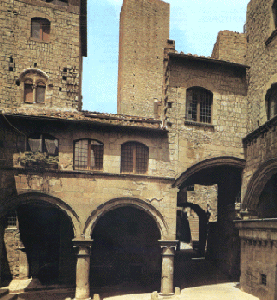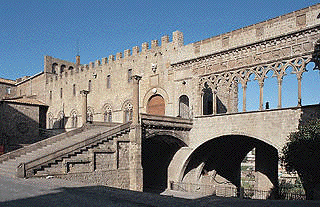WORKSHOP LOCATION
 The workshop will take place in Viterbo, one of the most famous medieval towns of Italy. Still enclosed within its walls, Viterbo has preserved a medieval appearance surprisingly unaltered and is even more colourful due to the survival of the ancient artisan traditions. Churches, edifices, towers, fountains, and the quarter of Saint Pellegrino, are all immersed together with its ancient construction of rock in an extraordinary captivating atmosphere. Viterbo was once the chief town of Tuscia, an area once possessed by the Etruscans, and boasts of archeological findings of this ancient and mysterious civilization found within its vicinity. The town's programs of cultural and folklore events are extremely entertaining and exciting.
The workshop will take place in Viterbo, one of the most famous medieval towns of Italy. Still enclosed within its walls, Viterbo has preserved a medieval appearance surprisingly unaltered and is even more colourful due to the survival of the ancient artisan traditions. Churches, edifices, towers, fountains, and the quarter of Saint Pellegrino, are all immersed together with its ancient construction of rock in an extraordinary captivating atmosphere. Viterbo was once the chief town of Tuscia, an area once possessed by the Etruscans, and boasts of archeological findings of this ancient and mysterious civilization found within its vicinity. The town's programs of cultural and folklore events are extremely entertaining and exciting.
Viterbo is 80 Km at North of Rome (with its airport, Fiumicino FCO), 150 Km at South of Florence, 90 Km at South of Siena, and 40 Km at West of Orvieto. The city is easily reachable from Rome and Florence by train or by bus. Every hour there is a train from/to the Rome airport Fiumicino (via Roma Trastevere); the journey lasts 2:15 hours. Every hour there is a train to/from the main Rome train station Termini; the journey takes 1:45 hours. At the Viterbo online tourist site you can find all the information about travelling to/from Viterbo and the city maps.
The History of Viterbo
Now, Viterbo is a pretty sleepy place. But in the 13th century it was one of the most prosperous and belligerent places in Italy, conquering neighboring towns, negotiating with the Holy Roman Emperors, kidnapping the College of Cardinals and trying to force them to vote for a candidate favored by the city fathers. They tried for some time to tempt the Holy Roman Emperors and the Popes to hold permanent courts in Viterbo, building a papal palace to persuade the pope that Viterbo was a much better place to stay than Rome. Viterbese political allegiances were never reliable, however, and they veered between a pro-papal and a pro-imperial policy with such frequency that the Emperor Frederick II is rumored to have said he would rather die and go to hell than negotiate with the Viterbese.
The San Pellegrino quarter is certainly the most characteristic and best conserved medieval quarter in Italy, a jewel of a 13th century contrada: the small squares, the houses, the narrow lanes, the arches and the characteristic profferli, the typical external stairs of the medieval houses of Viterbo. Among these, let us mention the Casa degli Alessandri because of its size and its complexity. From the tower which dominates the small Romanesque church of San Pellegrino you have a suggestive vision of the whole quarter.
The Palazzo dei Papi was begun as the Episcopal Palace in 1255, from 1257 on. With the arrival of Alexander IV the works were hurried and were completed in 1267 with the construction of the famous loggia, which in origin was a double one, but then the northern part collapsed under the excessive weight and has not been rebuilt ever since. An imposing flight of stairs lead to the building which contains the Conclave Hall. In total, five conclaves were held in this place: Urban IV (1261), Gregory X (1271, the longest lasting conclave of history: 2 years and 10 months), John XXI (1276, after the death of Cardinal Vicedomini, the pope of one day, before his consecration), Nicholas III (1277) and Martin V (1281). At the right of the Loggia begins the proper Episcopal Palace with the Throne Hall (Sala Gualtiero), the Gallery, the Library Hall, the Hall of Arms and the Appartment of the Cardinal.
The Viterbo area: Tuscia
Tuscia, now part of the province of Viterbo and one of the most culturally fascinating districts between northern Lazio and southern Tuscany, is an ancient Etruscan domain of which precious little is known. For years, travelers have sought to discover the secrets hidden in the remains left behind by the ancient civilization which used to inhabit these lands. Bolsena, an important town for the Etruscans, was also, centuries later, the setting for the miracle of Saint Cristina. In 292, the saint was tied to a stone and thrown into the eponymous lake, only to be brought back to shore by the stone itself. It was in the church dedicated to the saint that the Miracle of Bolsena took place and led to the institution of the Christian celebration of Corpus Christi. The Viterbo area has plenty of other monuments from later ages such as the Church of Montefiascone e di Bolsena, and Bisentina Island, where Sangallo il Giovane built the Farnese palace. The famous Farnese palace at Caprarola deserves special mention. It was from here that the Farnese family set out on military conquest and eventually reached the height of power in the form of a pontificate (Paul III). As it ranges from sea shore and lowland plain to a hilly terrain dotted with lakes, and finally the Cimini Mountains, this one area encapsulates many of the topographical features traditionally associated with the Italian countryside. The buildings are constructed using the local tufaceous rock and contrast quite sharply with the profusion of marble and stucco that is so typical of Roman architecture.
 Etruscan civilization is still shrouded in mystery. The Romans may have achieved many glorious deeds and vanquished all their neighbors, but they never quite eradicated the memory of the Etruscans, and a lingering fascination for this lost people remains. Veio, the Etruscan city-state closest to Rome, fell in the fourth century BC after a siege lasting a full 10 years. It was followed, one by one, by Cerveteri, Sutri, and Nepi, but Tarquinia, the city that captures the essence of the ancient land of Etruria, kept up the struggle throughout the entire fourth century BC, until finally forced into submission in 281 BC. The southernmost section of the Maremma, a mere sliver of the vast territory once controlled by the Etruscans, is the only part of the ancient Etruscan dominion to encroach into the present-day region of Lazio (or Latium). Though small, this area contains several major necropolis sites and is therefore the source of much of what we know about the Etruscan civilization. The Etruscans looked upon the tomb as an eternal home, and so they turned the burial chambers, from which we have derived much of our knowledge of them, into a replica of their houses and filled them with all the accoutrements of domestic life: jewels, pottery, bronze, and furnishings. A 150-hectare archaeological site (open to visitors) on the limestone plateau of Civita in Tarquinia contains one of the most important of all Etruscan monuments: the Temple of the Queen's Altar. This is the largest building of its type in all Etruria and the original site of the famous ceramic winged horses from the third century BC, now kept in the museum of the town. The museum also displays other artifacts taken from the tombs unearthed on the slopes of Monterozzi. Norcia boasts the largest and most impressive cavern-necropolis of Etruria. The necropolis of Tuscania yielded up many artifacts and remains of historical importance. Remains of the Etruscan civilization have also turned up in Ischia di Castro, Blera, Vetralla and Bolsena.
Etruscan civilization is still shrouded in mystery. The Romans may have achieved many glorious deeds and vanquished all their neighbors, but they never quite eradicated the memory of the Etruscans, and a lingering fascination for this lost people remains. Veio, the Etruscan city-state closest to Rome, fell in the fourth century BC after a siege lasting a full 10 years. It was followed, one by one, by Cerveteri, Sutri, and Nepi, but Tarquinia, the city that captures the essence of the ancient land of Etruria, kept up the struggle throughout the entire fourth century BC, until finally forced into submission in 281 BC. The southernmost section of the Maremma, a mere sliver of the vast territory once controlled by the Etruscans, is the only part of the ancient Etruscan dominion to encroach into the present-day region of Lazio (or Latium). Though small, this area contains several major necropolis sites and is therefore the source of much of what we know about the Etruscan civilization. The Etruscans looked upon the tomb as an eternal home, and so they turned the burial chambers, from which we have derived much of our knowledge of them, into a replica of their houses and filled them with all the accoutrements of domestic life: jewels, pottery, bronze, and furnishings. A 150-hectare archaeological site (open to visitors) on the limestone plateau of Civita in Tarquinia contains one of the most important of all Etruscan monuments: the Temple of the Queen's Altar. This is the largest building of its type in all Etruria and the original site of the famous ceramic winged horses from the third century BC, now kept in the museum of the town. The museum also displays other artifacts taken from the tombs unearthed on the slopes of Monterozzi. Norcia boasts the largest and most impressive cavern-necropolis of Etruria. The necropolis of Tuscania yielded up many artifacts and remains of historical importance. Remains of the Etruscan civilization have also turned up in Ischia di Castro, Blera, Vetralla and Bolsena.
The Workshop Venue
The workshop venue is the Mini Palace Hotel, situated at walking distance from the historical center of Viterbo, near Porta Romana. Each room is equipped with air conditioning, bathroom, telephone, mini-bar, TV and radio.
Mini Palace Hotel (****)
Via S. Maria della Grotticella, 2
01100 Viterbo - Italy.
Tel. +39-0761-309742/3/4
Fax. +39-0761-344715
E-mail: [email protected]